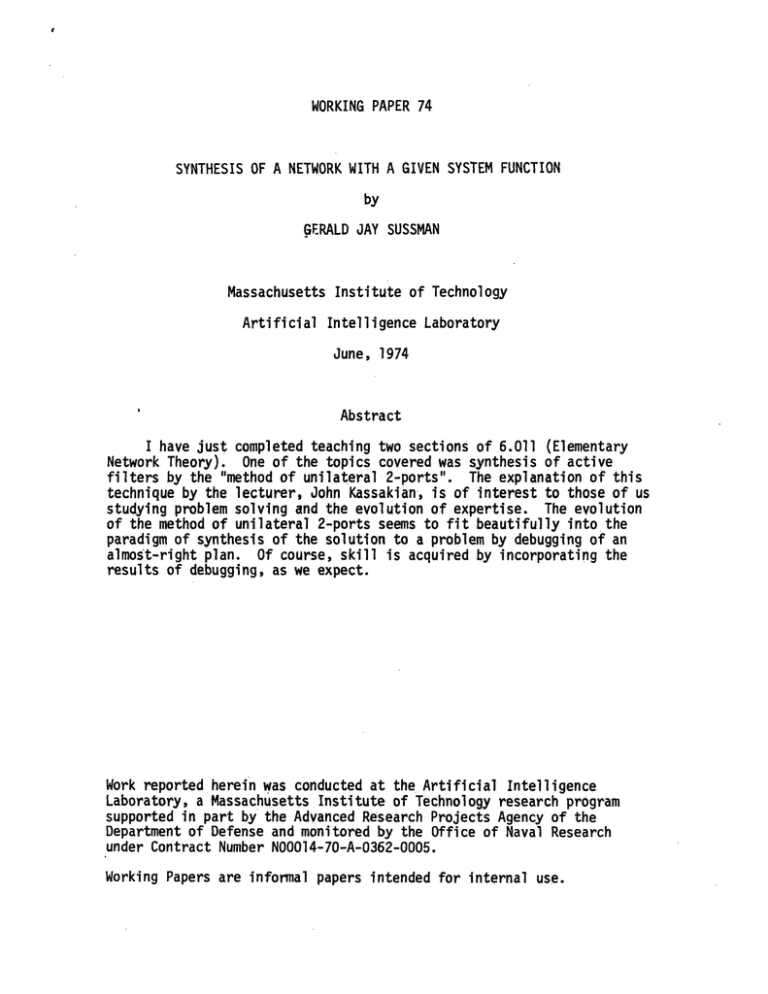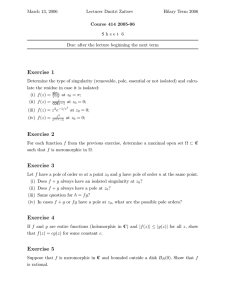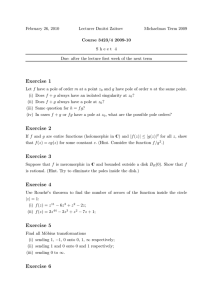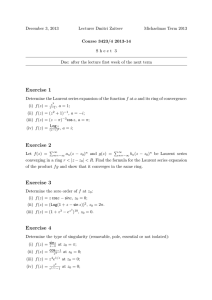by
advertisement

WORKING PAPER 74 SYNTHESIS OF A NETWORK WITH A GIVEN SYSTEM FUNCTION by GERALD JAY SUSSMAN Massachusetts Institute of Technology Artificial Intelligence Laboratory June, 1974 Abstract I have just completed teaching two sections of 6.011 (Elementary Network Theory). One of the topics covered was synthesis of active filters by the "method of unilateral 2-ports". The explanation of this technique by the lecturer, John Kassakian, is of interest to those of us studying problem solving and the evolution of expertise. The evolution of the method of unilateral 2-ports seems to fit beautifully into the paradigm of synthesis of the solution to a problem by debugging of an almost-right plan. Of course, skill is acquired by incorporating the results of debugging, as we expect. Work reported herein was conducted at the Artificial Intelligence Laboratory, a Massachusetts Institute of Technology research program supported in part by the Advanced Research Projects Agency of the Department of Defense and monitored by the Office of Naval Research under Contract Number N00014-70-A-0362-0005. Working Papers are informal papers intended for internal use. page 2 I have just completed teaching two sections of 6.011 (Elementary Network Theory). One of the topics covered was synthesis of active filters by the "method of unilateral 2-ports". The explanation of this technique by the lecturer, John Kassakian, is of interest to those of us studying problem solving and the evolution of expertise. of the method of unilateral 2-ports seems to fit The evolution beautifully into the paradigm of synthesis of the solution to a problem by debugging of an almost-right plan. Of course, skill is acquired by incorporating the results of debugging, as we expect. The problem posed is to construct a network with a given system function. Say, for example, we want a network having a voltage - transfer ratio whose magnitude varies with frequency in the following manner: IV.1 3V 0 Iw We check the Answer Library for a network, N, that matches this requirement. (An expert engineer would probably have an answer on tap for this simple a problem.) "Matches" is a rather complex idea -- features must be extracted such as the 'flat response" between Wl and w2, the fall off at frequencies above w2 and below wl, the positions of the "elbows", etc. If we don't find a direct plan for synthesis of the required network N in the Answer Library we try to break the problem into pieces which can be solved separately, with the idea of recomposing them later. page 3 The problem is not very decomposable in this form but there is a good transformation of the problem to be performed; let's transform the problem to a pole - zero plot. (This is an algorithmic transformation which requires careful measurement of the parameters of the magnitude plot.) We get: 1 zero at S = 0 1 pole at S = -wl 1 pole at S = -w2 ~'2 -'e Thus the required system function is of the form: Vd S= K (S + )( + w2) We still do not have any answer in the Answer Library which matches this pole - zero plot but we now have a way of breaking the problem into pieces. The system function has been factored -- it is really a product of simpler parts. But we have (in our "bag of tricks") a plan for realizing a product of system functions -- we can realize the factors and then form the product by "cascading": PLAN: V3 V3 1 V2 X V V1 page 4 If the system function had been a sum of terms, we would have a. different plan for decomposition: V4 = V2 + V 3 V 4 V4 = V2 + V 3 V1 V1 V1 Now, what are some plausible pieces to break our system function into? We look in our Answer Library to find what plausible subproblems there are. We have: 1 real pole: ----q jh V 1 R 1 V C 1 V2 1 R1C v V V1 1 R1 C1S + 1 1 1 pole and 1 zero: 1 poe ad 1 ero A r ( 4~ ~===~3 V 4 V4 = R2 C2 S 3 R2 2 S 1 R2C2S + V3 page 5 There are also many other realizations of these simple pole - zero plots in the Answer Library. For example, the input impedance of a parallel RC: I t- V I V = R3 R3 C3 S + 1 1 REAL POLE m This is not useful because we need a voltage transfer ratio to cascade. Anyway, we can break up our system function into two parts, one with I pole and the other with I pole and I zero, realize each separately, and (cascade the results. This is certainly not a unique process. We can divide up our poles and zeros as we please and realize our subproblems a variety of ways and recascade in any order -- these are design decisions which a well trained engineer would know lots about but a novice can try each one and use the one with minimum cost: Let's try to break it up as: Vo V Vi. = K + S +w So we propose the solution: + 1 S + (2) page 6 We now must try out the proposal to see if it works. We do analysis on this proposed solution (a unique algorithm) and find that the solution does not work, the poles do not come out at wl and w2 as we expected and we don't have the right K. Now it's time to debug! Why does this not work? Each subpart is known to work -- under some assumptions we must be violating by connecting things up the way we have. The plan, however, looks pretty good so we must have an interaction between the parts. What kind of interaction can we find? The characteristics of network NI are calculated under the assumption that it is a voltage divider -- that no current is drawn from the midpoint. The characteristics of NZ are calculated assuming its input is a voltage source -- that it can draw as much current as it likes without modifying its input. Here is the contradiction! This is a bug of the general form (N2 LOADS Nl). We can patch this kind of bug by introducing ISOLATION -- an amplifier (unilateral 2 - port). page 7 This circuit works and a good engineer would be expected to have compiled a critic which checks: "If you are about to cascade circuits to obtain the product of the voltage transfer ratios, check that the 2nd doesn't load the first. If there is a loading effect you need isolation." If as mentioned before, we tried to combine transfer functions by summation, other bugs can manifest, for example: If we wanted o 0 Vi i KIS S + 1 1 K2_ S +C2 2 we could try: page 8 V0 We find that the VO = VI and VZ is 0. It is shorted out! This is a bug of the form COMMON - GROUND - SHORT and may be repaired by "floating" one network relative to the other.








